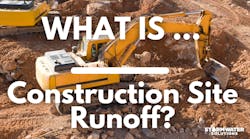Green Parking
The small, tight-knit community of White Settlement, Texas, has a rich history dating back to the 1840s. Today, as this city near the Dallas suburbs continues to grow, development efforts center on preserving the past while preparing for the future.
Keller High School, a newer school to the community, owns a piece of land across the street that is situated on a former cow pasture. Recently, when looking for a way to expand the popular high school football program’s parking area using this land, the city turned to local landscape architect Brian Adams, L.A., to help with the design.
Creating a “green” landscape that would preserve the natural beauty and charm of the area was a top priority. However, the area would also need to remain versatile, handling multiple uses ranging from overflow parking to accommodating the school band as a dedicated practice area.
The contractor was able to lay out the project within 10 days.
Solution & Installation
A key land management solution to the school’s landscaping needs was identified as the EZ Roll Grassroad Paver product from NDS Inc. Offering a weight-bearing capacity capable of handling light to heavy vehicular traffic, the product also touted the benefit of growing a healthy bed of grass beneath it. Due to the paver’s flexible grid design created from a series of hexagonal rings, weight load transfers to the road base, preventing soil compaction. As a result, soil is properly stabilized, and water, oxygen and carbon dioxide are able to feed and promote healthy root growth where grass can thrive.
Concrete paving was initially considered during the conceptual phases of the project. However, because concrete compromised the aesthetics of the landscape and would not significantly reduce hazardous storm water runoff, it was quickly ruled out as a green solution.
“Cost is important to my clients, and EZ Roll Grassroad Paver was a smart solution that I would use again as an alternative to concrete,” said Adams. “I like the fact that the grass looks good and meets my client's need for a flat and functional surface.”
The multipurpose area consisted of 150,000 sq ft, and the contractor was able to lay out the project within 10 days. The construction manager indicated that he liked the fact that the paver was simple to install. Available in pre-assembled rolls of 24-by-24-in. panels, its installation consisted of rolling the product out and clipping the mats together. The construction manager was able to cut around existing sprinkler heads and used a simple piece of PVC to assist his crew in rolling the paver out.
“EZ Roll Grass Paver offers creative solutions in storm water applications and still has the flexibility of creating different shapes that can match the natural lay of the land,” Adams said. “The malleable feature of the product allows it to lay flat or bend with small bends.”
The healthy turf finish offered by the paver was more cost-efficient.
Environmental Benefits
White Settlement made a point of requesting a green design for Keller High School. It was important to the community to demonstrate an ongoing commitment to supporting environmental factors for expansion in the city. Environmental regulations and green standards set by municipalities have increased the demand for permeable pavers, as more realize the important role landscaping plays within the larger scope of constructing a green building. Many grassroad and gravel pavers are made from recycled material and can also be used to achieve U.S. Green Building Council Leadership in Energy and Environmental Design credits.
By creating a more permeable surface, runoff is significantly reduced. Therefore, the amount of runoff going into storm drains is not only decreased, but so is the amount of pollutants filtering back into the ground. Permeable pavers are also effective in reducing the heat-island effect because turf provides less heat radiation than concrete.

